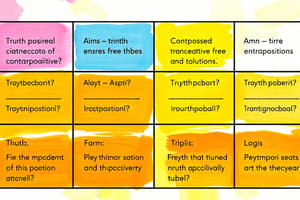Podcast
Questions and Answers
When you combine a conditional statement and its converse, you create a _______ ______.
When you combine a conditional statement and its converse, you create a _______ ______.
Biconditional statement
What is a biconditional statement?
What is a biconditional statement?
A statement that can be written in the form 'p if and only if q.' This means 'if p, then q' and 'if q, then p.'
What does p q mean?
What does p q mean?
p --> q and q --> p
Identify the conditionals within this biconditional statement: Two angles are congruent if and only if their measures are equal.
Identify the conditionals within this biconditional statement: Two angles are congruent if and only if their measures are equal.
For a biconditional statement to be true, both the ______ ____ and its ____ must be true.
For a biconditional statement to be true, both the ______ ____ and its ____ must be true.
If either the conditional or the converse is false, then the biconditional statement is ____.
If either the conditional or the converse is false, then the biconditional statement is ____.
In geometry, biconditional statements are used to write ______.
In geometry, biconditional statements are used to write ______.
What is the definition of a triangle?
What is the definition of a triangle?
What is the definition of a quadrilateral?
What is the definition of a quadrilateral?
Write a definition as a biconditional: 'A triangle is a three-sided polygon.'
Write a definition as a biconditional: 'A triangle is a three-sided polygon.'
What is the definition of a segment bisector?
What is the definition of a segment bisector?
Write the statement 'A ray, segment, or line is a segment bisector' as a biconditional.
Write the statement 'A ray, segment, or line is a segment bisector' as a biconditional.
Flashcards are hidden until you start studying
Study Notes
Biconditional Statements Overview
- A biconditional statement combines a conditional statement and its converse.
- Formulated as "p if and only if q," it implies both "if p, then q" and "if q, then p."
Understanding Biconditional Statements
- Biconditional statements clarify the relationship between conditions; both must be true for the statement to hold.
- If either the conditional or its converse is false, the biconditional statement is also false.
Conditional Statements in Geometry
- Essential for forming definitions in geometry; used to establish relationships between geometric concepts.
- Examples include "A figure is a triangle if and only if it is a three-sided polygon."
Important Definitions
- A triangle is defined as a three-sided polygon.
- A quadrilateral is defined as a four-sided polygon.
- A segment bisector is defined as a ray, segment, or line that divides a segment into two congruent segments.
Writing Biconditional Statements
- For each conditional, the converse should be constructed to form a biconditional statement.
- Definitions can be represented as biconditional statements to emphasize their necessity and sufficiency.
Examples of Definitions as Biconditional Statements
- A triangle can be expressed as a biconditional statement: "A figure is a triangle if and only if it is a three-sided polygon."
- Similarly, a segment bisector can be summed up as: "A ray, segment, or line is a segment bisector if and only if it divides a segment into two congruent segments."
Key Concepts
- For biconditional statements in mathematics, both conditional and converse must hold true to be valid.
- Understanding how to identify and write conditional statements and their converses is crucial in proving geometric concepts.
Studying That Suits You
Use AI to generate personalized quizzes and flashcards to suit your learning preferences.




